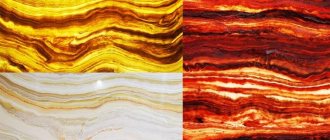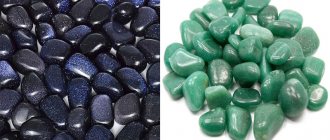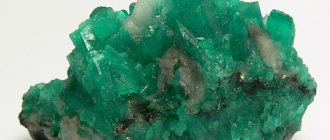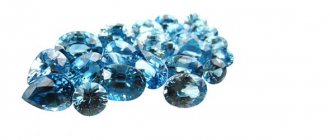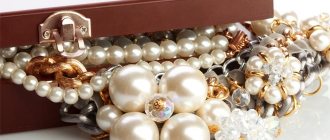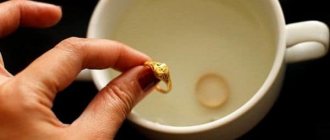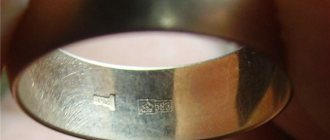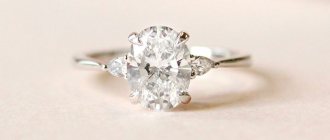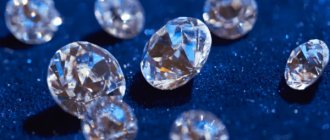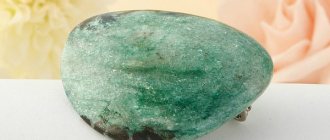Hello, dear readers! Do you already have malachite jewelry or are you just planning to buy it? In this case, you are probably wondering how to determine their authenticity. Malachite is a fantastic mineral; from ancient times to this day it has been shrouded in an aura of real magic. A talisman stone, a savior stone, a stone that connects with the secret world and opens a flow of abundance and prosperity for the owner. Of course, unscrupulous sellers often counterfeit such a wonderful mineral. From this article you will learn how to avoid becoming a victim of scammers - how to distinguish malachite from a fake.
Depletion of natural malachite deposits
Malachite initially could not be called a rare stone. However, the constant high demand for the gem led to the fact that numerous deposits were practically depleted, imitations poured into the market and the question of how to distinguish a fake from malachite began to arise more and more often.
At the moment, almost all places where stone is mined are concentrated in Africa, or more precisely in the Democratic Republic of the Congo (formerly Zaire), although previously it was actively mined in Russia, the CIS countries, and Western Europe.
In Soviet times, the Urals, Altai, and Kazakhstan were famous for their mining. But today the most famous mines of that time, in particular, in Nizhny Tagil (Mednorudyanskoye) and in Polevsky (Gumeshevskoye) are completely exhausted and do not function.
African malachite, which is the majority of the source of gem jewelry on the market today, has a number of notable features. Unlike stones previously mined in Russia, it has a larger, more regular and pronounced pattern of concentric rings. This reason, in particular, often causes problems in determining the authenticity of malachite among seasoned connoisseurs who are accustomed to the fact that a natural mineral should have an irregular, complex pattern.
History of the origin of the stone
The green mineral has been known since ancient times. The oldest deposits are about six thousand years old. The world's main reserves are located in northern and central Africa. In Russia, particular popularity manifested itself after the praise of the Ural stone by P. Bazhov in the legend “The Malachite Box”.
Initially, the green mineral malachite was not intended to create jewelry and decorative items. In ancient Egypt and some other states, copper was extracted from it to make tools. It was only in the Middle Ages that malachite semi-precious stone began to be used for crafts. Copper production began to be carried out in other ways. By that time the deposits had become somewhat depleted.
If we talk about such a mineral as malachite, its color cannot be described in a nutshell. But the beauty of the stone can be appreciated by visitors to the Hermitage and St. Isaac's Cathedral.
Raw malachite is simply a sample of the stone of one size or another. Advances have made it possible to accurately split blocks for further production of plates. Decorative mosaics began to be made from the material. Very malleable due to its low hardness and viscosity, it was easy to process.
The product can be completely carved from a single piece. But such large crafts are rare, because large blocks are rare in nature. Ural stone was processed using the “Russian mosaic” technique, selecting plates in accordance with the pattern. They made panels and vases.
Processed malachite is much more beautiful
Since ancient times, the gem has been credited with healing qualities. There is a well-known legend that during the cholera epidemic, only slaves in the malachite mines were not infected. Then the nobility in Egypt began to wear green bracelets as healing jewelry. Powder from crushed stone is used in cosmetics: eye shadow, ritual powder.
Variants of fakes of natural malachite
Counterfeiting natural malachite is not always an attempt to deceive. Due to the fact that stone jewelry always looks especially impressive and many people want to become the owner of an eccentric pendant or decorative item, imitation is still often just a need to satisfy demand and provide an opportunity to make a purchase on a limited budget.
In other words, in most cases the seller does not hide the fact that he is offering a fake, and the options for artificial products can be as follows:
- Malachite chips. The best option is, in fact, a very low-grade original. In this case, waste is used to create jewelry - small crumbs that are formed when making a product from a real large gem. The crumbs are glued together using epoxy resin and pressed in a special way. In fact, it is difficult to say unambiguously whether it is correct to call products made from crumbs fakes, since in this case the master still works with a real mineral, which has all the magical properties of the original, and, nevertheless, in the harsh rules of the jewelry world, such products are always in a controversial place.
- Synthetic gem. This is, in general, another controversial imitation. The synthetic gem is grown in laboratory conditions. It has the same chemical formula as a natural mineral and is indistinguishable in appearance, but since it is grown “in vitro”, it does not possess the magic of a natural stone.
- Imitation. In this case, we are talking about a clear counterfeit that has nothing to do with malachite. For counterfeiting, a stone of a different type is used; it is simply painted with a malachite pattern and coated with a protective varnish.
- Glass and plastic. They can paint not only another breed, but also glass or plastic. These are the lowest-grade fakes, which will not be difficult for anyone to distinguish, at least by weight. Glass and plastic feel completely different in your hands than stone.
All types of counterfeits of a natural product should cost less than the original. So a low price is one of the ways to distinguish malachite from a fake. However, problems begin when the seller is unscrupulous and tries to deceive - pass off the imitation as a natural gem and sell it for a high price.
Types and colors of stone
With green color, which is the main color for malachite, various shades are distinguished from the lightest to almost black. The varieties are given only a description; they are not given names.
Thus, African stones have rings of regular shape, larger in size than those of the Ural specimens. Contrast and brightness also make them stand out.
Natural malachite is a stone that is divided according to its color properties into the following subspecies:
- Plush or velvet with a fabric-like texture corresponding to the name. The fine-grained structure creates difficulties during processing, but the crafts are particularly beautiful.
- A finely patterned appearance with a cut pattern similar to birch leaves. Rarely discovered, it was considered to be of great value in the Urals.
- Pseudomalachite with a turquoise color is harder than real malachite, which is not considered to be.
It happens that the stone contains impurities of chrysocolla or other minerals. The color and pattern of the sample also changes in this case.
How to check malachite for authenticity
With careful inspection and a few simple experiments, determining the authenticity of a stone is not that difficult. Let's look at how to distinguish real malachite from a fake:
- Weight. First of all, we evaluate the weight. At this stage, the lowest-grade fakes - those made of plastic and glass - will be eliminated by themselves. It is worth noting that malachite is also heavier than many other stones, such as quartz, which is often used to create its imitation.
- Dullness. A real mineral is opaque, matte, its shine is barely noticeable, noble. If the mineral sparkles brightly with gloss or is transparent in light, it is certainly a fake.
- Heterogeneity. Despite the fact that the African rock, as we said above, has a regular pattern, no two identical stones exist in nature. This means that the answer to the question of how to check malachite for authenticity often lies in examining samples sold nearby. If they all look the same, you are looking at fakes; in the same case, when each gem is unique, most likely you are seeing originals.
- Shades. Heterogeneity should be expressed not only in the pattern, but also in color. When counterfeiting, the master, of course, uses several shades of paint, but, as a rule, no more than 3-4; nature creates a much more intricate play of color. It is noteworthy that they often try to pass off malachite as a coil. This is a natural breed, but less valuable. In order to identify these two minerals, you just need to carefully study the types of stones before purchasing. The obvious difference between malachite and serpentine is the shade of green; in the first case it is deep emerald, in the second it is closer to swamp.
- Test for ammonia and acids. If you have carried out an inspection, but still doubt the authenticity, and the seller insists on the naturalness of the stone, you can conduct two experiments, with the condition that if the mineral passes the test, you will definitely purchase it. These tests will slightly modify the stone, and therefore they should be carried out in an inconspicuous place, if we are talking about decoration - from its back. So, how to test malachite. The first test is to drop a drop of ammonia onto the mineral, wait a little, if this is the original, a section of the stone will turn pale and the drop itself will turn blue. The color change does not occur instantly, since natural gems are also coated with a protective varnish. The second test is acids. To make the acid, simply squeeze some lemon juice into a glass of warm water. Apply a drop of the solution to the gem; bubbles should appear on the surface, again, not immediately, if coated with varnish.
Please note that a synthetic mineral grown in a laboratory will withstand any test of authenticity. It is identical to natural in its chemical formula, physical properties and has a unique pattern. This means that there is no exact answer to the question of how to distinguish natural malachite from artificial malachite from the laboratory. In this case, the only guarantor of the authenticity of the stone is the integrity of the seller.
Well, now you know why the mineral is counterfeited today and how to distinguish malachite from an imitation. We really hope that the information provided will be helpful and useful to you. Don't forget to share it with your friends on social networks, perhaps they are planning to buy this beautiful stone right now.
Team LyubiKamni
Pressed mineral
Often, when a buyer doubts the authenticity of a material, the seller argues the quality by saying that it is a pressed sample. Pressed malachite is usually of natural origin, but of low grade. It consists of fragments and stone fragments of different sizes, pressed together and joined with epoxy resin. In these samples, sharp edges of fragments and partitions between inclusions are visible. Zones of epoxy resin with pebbles floating in it are clearly visible in the mineral.
Some pressed malachite products are very beautiful, but the quality is still lower than usual, and the price should not be increased accordingly.
How to buy, wear, care
The best time to buy jewelry is the green period. These are spring, when nature blooms, and the summer months until August. It is not recommended to acquire talismans in winter and autumn, since energy can be directed towards fading.
Rings with natural malachite are usually worn on the middle finger or little finger of the left hand.
There are no special rules for beads and bracelets. It is only necessary to aesthetically observe the rules of color combinations and compatibility with other stones. And also protect the decoration from damage. It is very easy to scratch; shocks and temperature changes are undesirable. Should be protected from household chemicals and acid exposure. Cleaning is done with a soft piece of cloth using a weak soap solution.
Which zodiac sign is malachite suitable as a talisman?
Malachite, recognized as the brightest stone in astrology, is ruled by Saturn. It suits almost everyone. Although the gem cannot be recommended for Cancers, Scorpios and Virgos, there is no combination with them in terms of qualities. But Taurus are among those whom malachite loves and suits, showing ideal compatibility.
All other signs can easily wear jewelry without fear of conflicts between the Zodiac and the stone, which plays the following roles in their lives.
- Libra will become eloquent, gain charm, and protect themselves from evil forces. The mood is stabilizing.
- Aries will say goodbye to stubbornness and gain restraint.
- Taurus people are clearly aware of reality. Although previously they looked for reasons for their failures in everything.
- Sagittarians will succeed in friendship, they will have the gift of mentoring, the desire to pass on their knowledge.
- Capricorns will become reasonable, the talisman will improve their sleep.
- Aquarius will stop being afraid of defeats and will forget grievances.
- Pisces will learn to focus on what is most important, think clearly, and choose the right path.
Malachite helps creativity. With its help, each sign will be able to enhance its charm and ability to evoke sympathy. You need to believe in the powers of the green mineral.
Magic ball made of malachite
